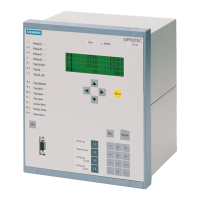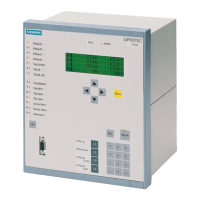Functions
2.4 Functional Scope
SIPROTEC, 7UM62, Manual
C53000-G1176-C149-7, Release date 03.2010
44
2.4.2 Setting Notes
Peculiarities
Most settings are self-explanatory. The special cases are described below.
If the setting group change function has to be used, address 103 Grp Chge OPTION must be set to enabled.
In this case, it is possible to apply two groups of settings for function parameters (refer also to Section 2.6) al-
lowing convenient and fast switch-over between these setting groups. The setting Disabled implies that only
one function parameter setting group can be applied and used.
Parameter 104 FAULT VALUE is used to specify whether the oscillographic fault recording should record
Instant. values or RMS values. If RMS values is stored, the available recording time increases by the
factor 16.
For some protection functions you can also choose the measuring inputs of the device to which they will be
allocated (side 1 or side 2); for other functions the allocation is fixed (see table 2-1).
For example, address 112 O/C PROT. I> allows such a choice for the I> stage of the time-overcurrent pro-
tection (= Side 1, Side 2 or Disabled).
For the high-current stage I>> of the overcurrent protection, address 113 O/C PROT. I>> determines whether
stage NonDirec. SIDE1 or NonDirec.SIDE 2 or Direc. SIDE1 or Direc. SIDE2 is to be operative.
By selecting Disabled, this overcurrent stage can be excluded altogether. For the inverse time overcurrent
protection 114 O/C PROT. Ip, different sets of dependent characteristics are available, depending on the
version ordered; they are either according to IEC or according to ANSI. This function, too, can be allocated to
either side 1 or side 2 (= IEC SIDE 1, ANSI SIDE 1, IEC SIDE 2, ANSI SIDE 2). Inverse time overcurrent
protection can be excluded altogether by selecting Disabled.
The following table shows the allocation of device inputs to the protection functions. The interdependencies
shown here must be kept in mind when configuring the power system. This concerns the U
E
input, the two sen-
sitive current inputs I
ee1
and I
ee2
as well as the 3 measuring transducer inputs (TD). Where the U
E
input is used
e.g. by the stator earth fault protection functions, it is no longer available for rotor earth fault protection (R, fn).
The same interdependencies apply for measured value transformer inputs. They can be used only by one pro-
tection function in each case. Where the TDs are not used by any protection function, they are available for
general processing by the measured value blocks in CFC.
Table 2-1 Allocation of Device Inputs to Protection Functions
Protection function Side 1 Side 2
U
L1
; U
L2
; U
L3
I
L1S1
; I
L2S1
;
I
L3S1
I
ee1
U
E
I
L1S2
; I
L2S2
;
I
L3S2
I
ee2
TD
Definite-time I>; I>> /non-directional Fixed Selectable – – Selectable – –
Definite-time I>>/directional Fixed Selectable – – Selectable – –
Inverse-time overcurrent protection Fixed Selectable – – Selectable – –
Thermal Overload Protection – – – – Fixed – TD2
Unbalanced load protection – – – – Fixed – –
Startup Overcurrent Protection – Selectable – – Selectable – –
Differential Protection (ANSI
87G/87M/87T)
– Fixed – – Fixed – –
Earth Fault Differential Protection U0 (calculat-
ed)
Selectable – – Selectable Fixed –
Underexcitation (Loss-of-Field) Protec-
tion (ANSI 40)
Fixed – – – Fixed – TD3
Reverse Power Protection (ANSI 32R) Fixed – – – Fixed – –
Forward power supervision Fixed – – – Fixed – –
Impedance protection Fixed – – – Fixed – –

